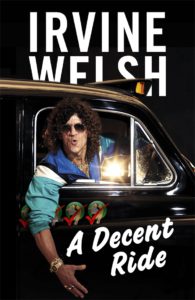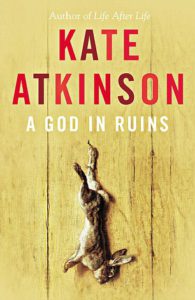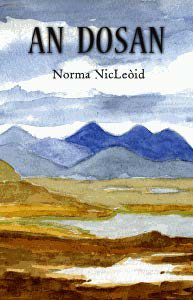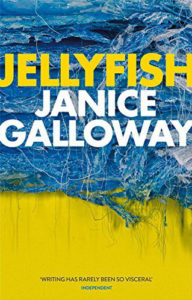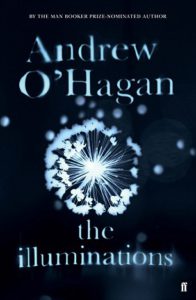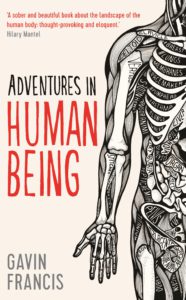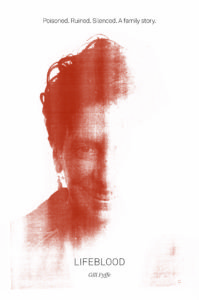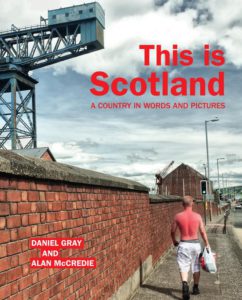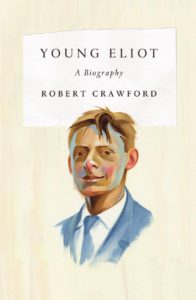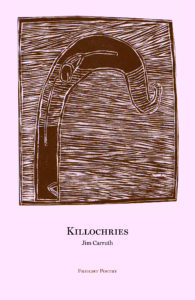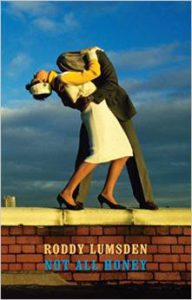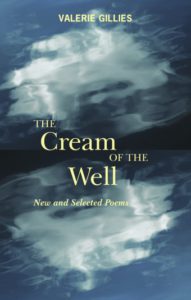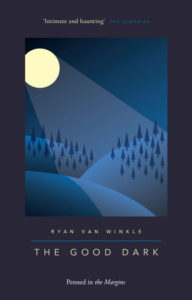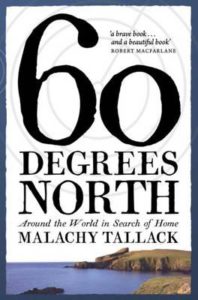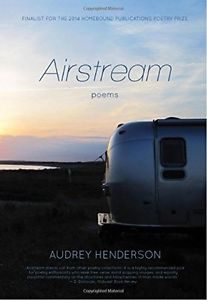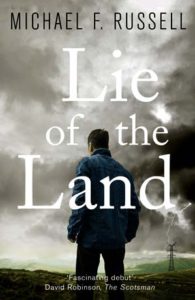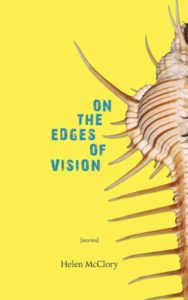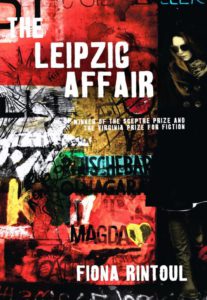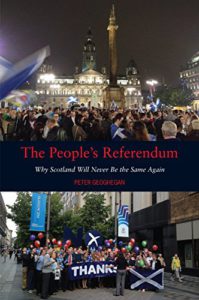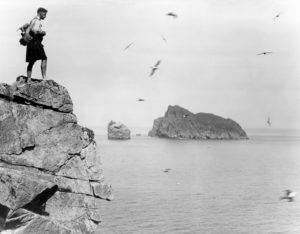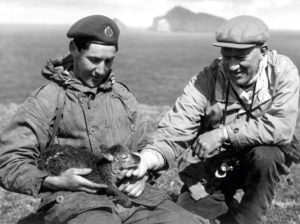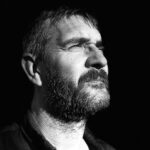A deft experiment in form, Aliyyah evokes the spirit of classic Arabian tales, whilst probing timely issues of science, materialism, religion and Western politics. It is a love story and a mystery, set in an unnamed, war-torn country.
Extract from Aliyyah
By Chris Dolan
Published by Vagabond Voices
Once Haldane woke everything was white. White ceiling, white walls, a white door open just enough to reveal a white corridor beyond. He moved his head and felt a murmur of pain somewhere. On the far wall the white was finally broken by an open window looking out on to a perfectly green tree with bright red buds. He dozed off and woke again to the same scene, several times over, until he was fully awake and strong enough to move his body. The same pain no matter which limb he moved. He pulled the white sheets back and saw that his left leg was bandaged from the ankle to the knee. He managed to sit up, and then stand without the pain becoming much worse. He hobbled towards the half-open door, and called out.
“Hello?”
Glancing back into the room he saw it contained only the bed he had been lying in and a chair, over which was a neatly draped uniform. Under the chair was a black box, about the size of a car battery, bent and battered. He turned and limped out into the long white narrow corridor. After about ten steps it opened out into a landing, at the left-hand side of which another window framed another green and red tree waving in a perfectly blue sky. The steps down into the rest of the house looked steep.
“Excuse me?”
Leading with the bandaged leg and holding on to the banister he made his way slowly down. There were pictures on the wall, portraits, of men mostly. But he had to concentrate on the steps, each of them of different depth, like the ones in the old manse.
The hall below had more portraits on the walls and a brightly patterned rug on the floor. There was a door to his left which must lead, he thought, out to the fruiting trees. A door behind the steps probably led to kitchens. In front of him were three more doors, one of which was open a crack and gave Haldane the impression of being occupied. On the flat he found he could walk more or less normally. He knocked and opened the door a little more.
“May I?”
The room was huge, several rugs or carpets, intricately patterned, covered less than half the floor. There were low tables made of carved wood, numerous chairs and divans, cushions of many colours on the furniture, all set on the floor’s bright green tiles. On a table at the far end sat a samovar and two glasses, and at the window stood a small figure staring out into the sun and a garden.
“Sir? I’m sorry but I…”
The man turned around. He seemed to Haldane, perhaps because he was at the other end of such a vast room, tiny. Dressed in a long white robe, a light brown waistcoat over it, and an embroidered hat, the little man smiled and held both his hands in the air. Behind his little groomed beard his smile was welcoming. Haldane thought it the most perfectly uncomplicated smile he had ever seen.
Neil Gaiman has said, ‘Books make great gifts because they have whole worlds inside of them. And it’s much cheaper to buy somebody a book than it is to buy them the whole world!’
Quite. And so I’d like to offer a selection of some of the most fascinating, moving, important little worlds I’ve had the privilege of inhabiting this year.
 More Letters of Note
More Letters of Note
Edited by Shaun Usher
Published by Canongate Books
Like its Sunday Times bestselling predecessor, this gorgeous collection of letters will enrich your life. Curated by Shaun Usher, it encompasses correspondence from such personalities as Jack London and Richard Burton, Helen Keller and Albus Dumbledore. If there’s a better way to spend Boxing Day than curled by the fire in a reindeer onesie, leafing through some of the most intimate, inspiring, funny and deeply moving correspondence in history, I don’t know what it is. More, please!
 A Portable Shelter
A Portable Shelter
By Kirsty Logan
Published by ASLS
We keep talking about Kirsty Logan, but, if you don’t know this bright young thing, you need to! The narrative thread connecting her most recent collection of short stories reads like a lullaby, and the stories are perfectly formed little gems – rough, unflinching, beautiful and filled with hope. The limited edition is still available in good book shops, but will surely be gone soon. It’s gorgeously gift-sized, and a soon-to-be-released paperback edition means you can get a second copy for you. Think of it as all part of the gift – the person to whom you give this book will definitely want to discuss.
 Dogs in Snow
Dogs in Snow
Published by Black & White
There’s absolutely nothing I can add to this, except to say that it’s every bit as adorable and joyful as it sounds.
 A Notable Woman
A Notable Woman
By Jean Lucey Pratt, edited by Simon Garfield
Published by Canongate Books
Surely destined to take her place amongst the world’s most memorable and influential diarists, Jean Lucey Pratt was a businesswoman, a bookseller, an early feminist, a wartime survivor, a lover of tennis, and an unreformed cat lady. Mostly, she was delightfully ordinary and a keen observer of life, and she’s left behind a beautifully prosaic legacy of 20th century Britain. I want to be this woman, and the good news is that, when you read these journals so artfully edited by Simon Garfield, you realise that there’s a little bit of Jean about all of us.
 Scotland’s Lost Gardens
Scotland’s Lost Gardens
By Marilyn Brown
Published by RCAHMS
I’ve a black thumb (or whatever appendage belongs to incorrigible plant-killers), but I hold a deep (and somewhat envious) admiration for beautiful gardens. Replete with old photographs and illustrations, this is a rich cultural history of Scotland told through its gardens, and a real celebration of the transient. It’s a book fit for leafing nostalgically, as much for the sake of noting the passing beauty around you as for the beauty that has been.
 The Book of Strange New Things
The Book of Strange New Things
By Michel Faber
Published by Canongate Books
Named the Saltire Society’s Book of the Year, this book feels like a truly special publishing event. It is almost impossible to separate the writing of this book from author Michel Faber’s deeply moving relationship with his late wife, and he has achieved a poignant exploration of the enduring quality of love across space and time. With a V&A design award among its many accolades, it’s a book you definitely want on your shelf – but there’s no chance it will sit there for long.
 Thorfinn and the Awful Invasion
Thorfinn and the Awful Invasion
By David MacPhail
Published by Floris Books
Know a young reader who devours Horrid Henry or the Diary of a Wimpy Kid? They’ll love Thorfinn. He’s an unlikely little Viking, well-mannered and rather lovely and, frankly, a little bit out of place. But he has a great big heart, and, at the end of the day, is just the guy for the job. This book is fast-paced, very funny and full of energetic illustrations from Richard Morgan. A real pleasure, and, as part of a series, a gift to keep on giving.
 The Social Bite Cookbook
The Social Bite Cookbook
Edited by Margaret Callaghan
Published by Freight Books
Everybody wins with this cookbook. Social Bite trains and employs formerly homeless people to work in their cafes, and this cookbook is filled with warm, accessible recipes from its staff. Part delicious recipe collection, part ground-breaking social enterprise, part my-new-lunchtime-staple, Social Bite is one of my favourites this year. 50% of all profits from the book go to help the homeless.
 Witches and Wicked Bodies
Witches and Wicked Bodies
By Deanna Petherbridge
Published by National Galleries of Scotland
At first blush, you could be forgiven for not having this at the top of your Christmas wish list. But the representation of women’s bodies could hardly be more relevant, and editor Deanna Petherbridge provides insightful commentary on the history of this representation, with women appearing in the guise of everything from dangerous crone to tempting seductress. It’s a fascinating curation that will keep you thinking. That said, I could really have chosen almost anything from the publishing catalogue of the National Galleries of Scotland, as each of their books is a highly-produced, visual pleasure, with the represented art well contextualised by experts from the field.
 Encounters in the Wild
Encounters in the Wild
By Jim Crumley
Published by Saraband Books
A growing series from one of the country’s best-loved nature writers, it so far includes Barn Owl, Fox, Swan and Hare. These books are quiet, reflective and focussed considerations of the British landscape, evoking the spirit of some of the most iconic species native to this land. As small, illustrated hardbacks, they’re excellent for stockings, a beautiful thing both inside and out.
 A Petrol Scented Spring
A Petrol Scented Spring
By Ajay Close
Published by Sandstone Books
Ajay Close is a novelist of not inconsiderable talents, with taut prose, emotional intelligence and a cracking storyline. Her newest novel examines women’s struggle for emancipation during British suffrage. Think Suffragette the film, but with a more satisfying plotline and without the Meryl Streep cameo (that bit’s a shame). This is an important novel that’s a real page-turner, to boot.
 Secret Garden: An Inky Treasure Hunt and Colouring Book
Secret Garden: An Inky Treasure Hunt and Colouring Book
By Johanna Basford
Published by Laurence King
The colouring book craze is here to stay for the moment, and they really don’t come any prettier than this. The illustrations are intricate enough for simply looking, and, if you (like me) enjoy using all the coloured pencils, that same intricacy means you are definitely in for a treat.
 The Bonniest Companie
The Bonniest Companie
Kathleen Jamie
Published by Picador
Confession: I’ve not yet read this book. It’s at the very top of my want list (and, yes, I’m accepting any and all offerings). I have read from this collection, and it is undoubtedly the voice I fell in love with in ‘The Queen of Sheba’ so many years ago – quieter, perhaps, more grounded, and every bit as moving. These poems trace a year through the Scottish landscape, urban and wild, and, because the elucidation of poetry often kills it, it’s probably best to simply offer a few lines:
Can you please say spring / will be there soon? / It’s creeping up the mountain / as though carried on an old woman’s back. / When we’re old women / we will fetch spring too.
There you are, now you understand. No doubt you’ve moved it right to the top of your list, as well.
Continuing the long tradition of the Saltire Society Literary Awards engaging with the many different kinds of literature Scotland has to offer, for the first time this year we are expanding one of our awards into two categories for Fiction and Non-Fiction books. The Fiction Book of the Year Award celebrates the best fiction from, and about, Scotland.
A Decent Ride
by Irvine Welsh
Published by Jonathan Cape
The title says it all,but the book must be read to bring out the joyful impudence of the joke. Welsh pushes the boundaries once more in an irreverent plunge into an Edinburgh not covered in the guide-books. An up-to-date and hugely entertaining satire — sometimes grotesque, but full of humanity.
What the shadow panel said:
The humour of Welsh’s most recent novel was praised and the local Edinburgh setting appreciated as being typical Welsh.
A God in Ruins
by Kate Atkinson
Published by Transworld Publishers
A fine historical novel about Bomber Command’s war — but also a moving meditation about life and death, about time and aging, and about the novelist’s art itself. Seriousness is counterpointed by Atkinson’s characteristic wit, and by a sense of the author’s own commitment to her subject-matter.
What the shadow panel said:
The shadow panel appreciated the unquestionable quality and beauty of the writing in Atkinson’s latest novel. Her weaving of the stories of several characters over different time periods was noted as exemplifying Atkinson’s unique skills.
An Dosan
by Norma McLeod
Published by Acair Books
Norma MacLeod’s An Dosan cleverly combines two narratives within one novel. The novel, which is lucidly and elegantly written, is also experimental within the canon of Gaelic literature in its use of the novel within a novel structure.
What the shadow panel said:
The sole Gaelic reader on the shadow panel understood An Dosan to be the first of its kind in Gaelic literature thematically and found it to be an interesting commentary on authorship. He found it to effectively draw on Gaelic culture and be of considerable merit.
Jellyfish
by Janice Galloway
Published by Freight Books
What the panel said:
A short story collection with incisive studies of human interaction in a wide variety of situations, sparely written, startlingly original and unexpected. Sentences start, go unexpectedly, sometimes (like human speech) don’t finish. A challenging and very satisfying read.
What the shadow panel said:
The strength of these short stories greatly impressed the panel though different stories resonated with different members. Where some preferred the shorter, erotically charged tales others appreciated Galloway’s bravely tackled tales of darkness in the every day.
The Book of Strange New Things
by Michel Faber
Published by Canongate Books
Startlingly original, compounded of several genres (and a skilful use of science fiction), searchingly discussing human relationships under extreme stress and looking beyond human relationships. A completely original and very readable book.
What the shadow panel said:
This was a panel favourite for its accessible use of sci-fi and thrilling vision. The writing was found to be beautiful and the story gripping. The panel was impressed and moved by this title. Although one of the longest novels on the list, it was considered to be a real page turner.
The Illuminations
by Andrew O’Hagan
Published by Faber & Faber
Parallels stories which seem too diverse for one novel: an old woman’s final failing and loss of independence, and a young soldier’s bitter experience of the war in Afghanistan. O’Hagan’s sensitive and thoughtful novel unites them in a gently hopeful resolution.
What the shadow panel said:
Another panel favourite, The Illuminations was found to be a quick read but a memorable and powerful one. The thematic parallels of an elderly creative mind lost to dementia and her grandson traumatized by war were highly praised as heart-breakingly effective. A beautiful and emotionally-charged gem.
Stevie Marsden, PhD Researcher and Literary Awards Administrative Assistant at the Saltire Society:
This is the first year the Saltire Society has instituted a ‘shadow judging panel’ scheme for four of their literary award categories: Fiction, First Book, Non Fiction and Poetry. The purpose of the shadow judging panels was to offer young publishers, students and booksellers the opportunity to read the shortlists for these four categories and come together to discuss and judge the books. Through a fantastic partnership with the Society for Young Publishers, Scotland, this scheme has been hugely successful, with all of the participants commenting about how exciting this unique opportunity to engage with Scottish literature in this way was. The Saltire Society has been delighted that so many young publishers, booksellers and future publishers have had the opportunity to experience what it feels like to be in the judges chair!
The judging panel for the First Book of the Year Shortlist is:
Professor Ian Campbell – Dr Ann Matheson – Hannah McGill – Joyce McMillan – Jenny Niven – Dr David Robb – David Robinson – Professor Mark Wringe
The shadow panel for the First Book of the Year Shortlist is:
Keira Brown (Chair)- Laura Jones – Laura Borrelli – Sophie Pinkoski – Stephanie Cargill-Greer – Liam Alastair Crouse (Gaelic advisor)
There has always been a great tradition of non-fiction writing in Scotland, and it is an area of Scottish literature that continues to thrive. It is for such reasons that, in 2015, the Saltire Society expanded its series of awards to include one for the best non-fiction books by Scottish authors or about a Scottish theme or issue.
Adventures in Being Human
by Gavin Francis
Published by Profile Books
A book which takes the reader through surgery, blood, dissection and much squeamish tissue turns out to be totally approachable and wonderfully instructive. Francis offers a chance to appreciate as never before the miracle of the human body we inhabit. An Edinburgh GP, he spends his days keeping the human being ticking over.
What the shadow panel said:
Gavin Francis’ book opened up a new world of medical narrative to most of the panel. It is a fascinating read that we agreed would appeal to a wide audience. We particularly like this new way of measuring a book – rather than being at chapter 9 or 10 we found ourselves instead at the Abdomen or Pelvis.
Lifeblood
by Gill Fyffe
Published by Freight Books
This is a brave book, dominated by questions of blood after an accidental infusion of tainted blood. The book never offers facile comfort: it confronts human error, human bravery and human incompetence. Personal courage and family support offer life from day to day, but the taint in the blood is always there.
What the shadow panel said:
An important and timely memoir, Lifeblood tells one woman’s story of the devastating effect of failures by the NHS to screen donated blood for Hepatitis C. The book has a wonderful literary feel to it that helped it avoid a more typical ‘misery memoir’ vibe. It was popular with the panel as it informed the reader on these terrible events but also showed the emotional and personal impact it had on Gill Fyffe’s life.
This is Scotland
by Daniel Gray and Alan McCredie
Published by Luath Press
To describe this as a book of photographs of selected Scottish places, and short essays on these places, does not begin to do justice to the quirky originality of this book. The unexpected areas to draw out in the chosen places and the deliberate banality of some of the images counter the too-easy coffee table visions of Scotland.
What the shadow panel said:
This Is Scotland illustrates an interesting mix of random Scottish communities. Unusually for a book of this type it focuses on the urban face of Scotland over the rolling landscapes. It was nice to see a different approach taken with the aim to avoid the more typical glimpse of Scotland so often on the shelves.
Young Eliot
by Robert Crawford
Published by Jonathan Cape
Crawford meticulously reconstructs from a wealth of research the young Eliot as he emerges from a rather unfamiliar USA background into early manhood and the tumultuous years which produced his great later poetry. The second volume will be something to look forward to, completing an Eliot we have not had access to so far.
What the shadow panel said:
While somewhat intimidating at first glance, Young Eliot is a tremendously well researched biography and offers new insight into the early life of this influential writer. Probably most suitable for the Eliot super-fan and dedicated scholars it was nevertheless very enjoyable to get to know young Tom.
Stevie Marsden, PhD Researcher and Literary Awards Administrative Assistant at the Saltire Society:
This is the first year the Saltire Society has instituted a ‘shadow judging panel’ scheme for four of their literary award categories: Fiction, First Book, Non Fiction and Poetry. The purpose of the shadow judging panels was to offer young publishers, students and booksellers the opportunity to read the shortlists for these four categories and come together to discuss and judge the books. Through a fantastic partnership with the Society for Young Publishers, Scotland, this scheme has been hugely successful, with all of the participants commenting about how exciting this unique opportunity to engage with Scottish literature in this way was. The Saltire Society has been delighted that so many young publishers, booksellers and future publishers have had the opportunity to experience what it feels like to be in the judges chair!
The judging panel for the Non-Fiction Book of the Year Shortlist is:
Professor Ian Campbell – Dr Ann Matheson – Hannah McGill – Joyce McMillan – Jenny Niven – Dr David Robb – David Robinson – Professor Mark Wringe
The shadow panel for the Non-Fiction Book of the Year Shortlist is:
Catriona Cox (Chair) – Fiona Wesley – Isobel Urwin – Julia Crawford – Megan Reid – Silje Graffer
First awarded in 2014, the Poetry Book of the Year Award highlights collections of new poetry and recognises the significant contribution poetry makes to Scottish culture, reflecting a great Scottish literary tradition that is still thriving in the 21st century.
Killochries
by Jim Carruth
Published by Freight Books
The beautiful, hard, spare lines perform the work of a much longer novel. A young man broken by drink and drugs spends a remedial year with an unyielding old relative on a bleak country farm. Carruth bravely shows that nature, poetry and belief can combine to make life better, while avoiding the pretense that all will be well.
Not All Honey
by Roddy Lumsden
Published by Bloodaxe Books
Not All Honey may not be all sweetness but it’s all a delight to consume. Lumsden typically is tricksy and evasive, juggling, acrobatic. His professional portmanteau full of linguistic surprises. Yet, he has reached a kind of Dantean point in his poetic life which makes him suddenly offer devastating clarities that justify the fireworks.
The Cream of the Well
by Valerie Gillies
Published by Luath Press
This book contains a lifetime of observation, capturing the essence of the poet’s experiences in beautifully crafted poems whose form often follows the rise and fall of landscapes and birdsong. The new poems migrate from the history and shapes of the Scottish terrain she loves to the swamps and woods of America, finding delights and echoes across the Atlantic.
The Good Dark
by Ryan van Winkle
Published by Penned in the Margins
Van Winkle works with the language of love and love lost till it is scarcely recoverable but which still nourishes the lover’s past and present. His range is remarkable: everything invokes everything else, the tactile calls in the intellectual, one poem calls in every other poem, mundane tasks call in whole physical and emotional worlds.
The judging panel for the First Book of the Year Shortlist is:
Dr Robyn Marsack – Dorothy McMillan – Professor Rory Watson
Celebrating emerging talent and fresh ideas, the First Book of the Year Award is dedicated to first-time authors who have not previously been published, and can be awarded to both fiction or non-fiction books.
60 Degrees North
by Malachy Tallack
Published by Polygon
Essays suggested by that line on the atlas – 60 degrees North – and the countries that line passes through, bound by the encounters with cold, distance, bleakness and human survival against challenging conditions. The author’s quirky interests and determination against difficult conditions make for a rewarding travel account.
What the shadow panel said:
The concept of travelling the 60th parallel is interesting, and Malachy is great at giving each destination its own identity. Every passing character has context, and while 60 Degrees North is a travel book, it reads like a well-written novel. It reaches out to anyone who has ever felt uncertainty about where home really is.
Airstream
by Audrey Henderson
Published by Homebound Publications
Airstream recounts the poet’s travels and passing encounters, snatches of conversation and memory, all made luminous and meaningful in a style of informally oblique personal statement. Henderson has a genuinely engaging voice —deceptively inconsequential in delivery— revealing a perceptive and witty sensibility at work.
What the shadow panel said:
Airstream feels like a story, taking the reader on a journey through poetry. When the flow between them was just right, the collection could sweep the reader away. It brought places like the National Library to life with its own personality, and hooked us with many moments of truly passionate writing.
Lie of the Land
by Michael F. Russell
Published by Polygon
A bleak and dystopian vision of a Scotland where an apocalypse (never closely defined) has all but destroyed the familiar, and where the survivors are hemmed in and controlled by a never seen but always powerful authority. The narrator is a survivor, desperate to make contact with a past all but brutally erased. It is terribly believable.
What the shadow panel said:
This had an exciting premise and 1984 vibes in a not-too-distant future Scotland. Although it was a dystopian book the socio-political issues surrounding this were never really explored. The reason behind everything, or even the potential implications of it, wasn’t dealt with. Lie of the Land promised a lot from the beginning that was never really seen.
On the Edges of Vision
by Helen McClory
Published by Queen’s Ferry Press
These are dark stories about the limits of the conscious and the darkness within. About a world where reality flickers in and out of focus disturbingly. The familiar is even more disturbing than the unfamiliar. These are stories that draw you back to re-read, but they continue to squirm out of final reach.
What the shadow panel said:
This is creepy and made us feel uncomfortable, but in an enjoyable way. Despite the mass of stories they all flow together, with a Pan’s Labyrinth/Coraline vibe to much of it. Even in the shortest stories, the characters are well-formed, and unlike anything we’d read. Ambitious and engaging.
The Liepzig Affair
by Fiona Rintoul
Published by Aurora Metro Books, Ltd
A substantial and ambitious addition to the world of the Cold War spy thriller: a Scottish postgraduate student becomes involved with East German dissidents. A first book of immense confidence, its plot and atmosphere reveal a fully-fledged master of the genre.
What the shadow panel said:
The structure of first person and second person alternating narratives and times (one in the present, one looking back) is what many on the panel liked, and others found difficult. Either way, we felt the characters were so well developed and believable in this book that it was the most impressive, in that, sense for reality.
The People’s Referendum
by Peter Geogheghan
Published by Luath Press
History in the making, as experienced by the people of Scotland. Peter Geogheghan recorded the feelings and attitudes, the hopes and fears, of a varied cross-section of Scottish communities and cultures as the day of national decision, in September 2014, approached.
What the shadow panel said:
Geoghegan made a real attempt to remain balanced on a topic that’s often reported with bias, tying everything back to Scotland’s referendum. Other places and people were given their moment, but the language didn’t always match the topic at hand. It was, however, easy to read even for those not into politics.
Stevie Marsden, PhD Researcher and Literary Awards Administrative Assistant at the Saltire Society:
This is the first year the Saltire Society has instituted a ‘shadow judging panel’ scheme for four of their literary award categories: Fiction, First Book, Non Fiction and Poetry. The purpose of the shadow judging panels was to offer young publishers, students and booksellers the opportunity to read the shortlists for these four categories and come together to discuss and judge the books. Through a fantastic partnership with the Society for Young Publishers, Scotland, this scheme has been hugely successful, with all of the participants commenting about how exciting this unique opportunity to engage with Scottish literature in this way was. The Saltire Society has been delighted that so many young publishers, booksellers and future publishers have had the opportunity to experience what it feels like to be in the judges chair!
The judging panel for the First Book of the Year Shortlist is:
Professor Ian Campbell – Dr Ann Matheson – Hannah McGill – Joyce McMillan – Jenny Niven – Dr David Robb – David Robinson – Professor Mark Wringe
The shadow panel for the First Book of the Year Shortlist is:
Heather McDaid – Charlotte Brady – Justine Bottles – Julia Crawford – Jo O’Brien – Nathaniel Kunitskaya
This island represents an enigmatic and awe-inspiring landscape, a starkly beautiful vision of ‘life on the edge’ which has fascinated everyone from travellers, antiquarians and conservationists to writers, film crews and tourists. And, perhaps as a result, it is one of the most mythologised and misunderstood places on earth. In this new book, archaeologists Angela Gannon and George Geddes turn the popular perception of the archipelago on its head to tell a compelling story of triumph over geographical adversity.
Extract from St. Kilda: The Last and Outmost Island
By Angela Gannon and George Geddes
Published by RCHAMS
The first travellers to St. Kilda must have prepared carefully for their trip across the daunting Atlantic waters, readying their boat, gathering food and fuel, and looking out for good weather conditions.
In the 17th and 18th centuries, the journeys made by the islands’ tacksman were sometimes transformed into battles for survival – in one case during the 1690s, tacksman Alexander MacLeod and his party were blown off course by some 200km to the island of North Rona, where they were forced to spend the winter. For the St. Kildans themselves, careful preparation and good weather were prerequisites for visits to the outlying islands and stacks; even the closest island of Dun presented a significant and treacherous challenge, three men drowning there in 1909. A sense of danger and adventure has been at the heart of visitor and islander experience on St. Kilda since the very beginning. There is little doubt, however, that the evacuation encouraged intrepid scientists, who were more than happy to take on the challenge of living and working on the archipelago without help from anyone else. The 1931 St. Kilda expedition, made up of students from Oxford and Cambridge Universities, and led by ‘one of the foremost scientists of his generation’, David Lack, was a defining example. Visitors after the evacuation also included Robert Atkinson, whose Island Going ranks among the best of all Hebridean travel books. Atkinson and his companion John Ainslie began their island adventure in 1935 with a trip to Handa, driving up in Atkinson’s mother’s car. His interest went beyond ornithology and his photographs, now held at the School of Scottish Studies, form a unique record of St. Kilda’s archaeology and architecture.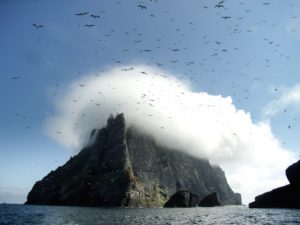
Combining the close study of natural history with a more general description of the islands they visited, Lack and Atkinson paved the way for scientists like John Morton Boyd, for whom St. Kilda would be a rite of passage on his way to becoming the Head of the Nature Conservancy. In 1969, Boyd described how ‘St. Kilda has always been a great event for me. My first visit to the islands in 1952 was my breaking clear of a life where mediocrity provided enough incentive for mediocre achievement. St. Kilda has been my emblem of endeavours and I swear that if I were ever to make recognition of one place as having influenced me more than another, I would not choose Canada or Africa or Britain, but St. Kilda.’ The opportunity to combine adventure with conservation was opened up to a wider community in 1958 when the first of the National Trust for Scotland (NTS) work parties came to the island, a tradition that has continued to this day.
The volunteers, many of whom have returned time and again, were behind the creation of the St. Kilda Club in 1976, and the periodical the St. Kilda Mail, whose first edition described how for ‘those who prefer a challenging, strenuous but very satisfying vacation, a visit to St. Kilda … is surely a must’. In that same issue, the warden, George Wood, wrote of how ‘early in May Dr Mike Harris and Stewart [sic] Murray were engaged on a Puffin study and swinging across the Breaches Buoy with them I enjoyed two wonderful days on Dun’. Stuart Murray first came to St. Kilda in 1974 and in a few short years he had taken every opportunity to explore the archipelago, reaching all of the outer islands and stacks. Stuart’s abilities as a guide and climber were to have a great influence on the survey begun by Mary Harman in 1977. His contribution was no less important to the work of the Royal Commission on the Ancient and Historical Monuments of Scotland (RCAHMS) in the 1980s and 2000s, whether on Dun and Boreray, or on islands like North Rona and the Flannans. Our records of archaeological sites on the stacks still rely on the work of Murray and Harman before 1985. In his comprehensive Natural History of St. Kilda John Love was able to venture that ‘no one today … knows St. Kilda as intimately’. For Stuart, Island Going has become a way of life, where adventure and research are interwoven and inextricably linked.
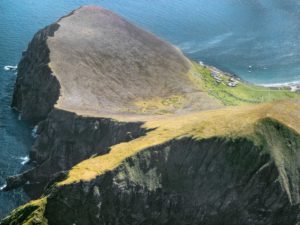 On 26 February 1908, when RCAHMS first met in Edinburgh at 29 St Andrew Square and discussed how they would ‘make an Inventory’, they settled upon a fundamental principle – it was essential that the staff should undertake fieldwork, ‘personally inspecting each monument so as to satisfy your Commissioners as to its true character and condition’. Expeditions to islands became commonplace, beginning with Fidra in the Firth of Forth in 1913 and many of the Outer Hebridean islands between 1914 and 1926. Adventures by boat reached an apex during the survey of Argyll, when the purchase of a dedicated vessel became necessary. In the 1980s, St Kilda presented a unique challenge, through the complications of the survey, and the uncertainties involved in travel to and from the island. Conditions were much more straightforward during the 2007 to 2009 survey, with the facilities offered by the NTS ever-improving.
On 26 February 1908, when RCAHMS first met in Edinburgh at 29 St Andrew Square and discussed how they would ‘make an Inventory’, they settled upon a fundamental principle – it was essential that the staff should undertake fieldwork, ‘personally inspecting each monument so as to satisfy your Commissioners as to its true character and condition’. Expeditions to islands became commonplace, beginning with Fidra in the Firth of Forth in 1913 and many of the Outer Hebridean islands between 1914 and 1926. Adventures by boat reached an apex during the survey of Argyll, when the purchase of a dedicated vessel became necessary. In the 1980s, St Kilda presented a unique challenge, through the complications of the survey, and the uncertainties involved in travel to and from the island. Conditions were much more straightforward during the 2007 to 2009 survey, with the facilities offered by the NTS ever-improving.
Perhaps the only ‘true’ expedition that formed part of this project was the survey of Boreray in 2010. Camping among the Cleitean MacPhaidein, the team endured a storm of terrifying ferocity and witnessed the richest sunsets imaginable while recording in detail the dense archaeological landscape. Three years later, another team set out from Leverburgh at 4am with the express aim of landing on Stac an Àrmainn and recording the incredible evidence of fowling that still survives on its craggy slopes. This was sadly prevented by a tremendous sea swell, which was only appreciated when the boat was within metres of the rocks.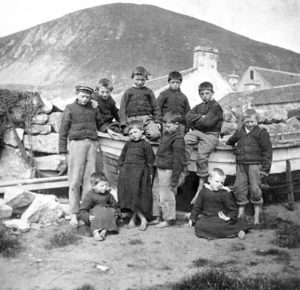
Far more than allowing us to assess the character and condition of St. Kilda’s monuments, our expeditions to the archipelago have provided a remarkable opportunity to understand the nature of living and working on the islands. It has brought into focus what was, for the St. Kildan, an everyday experience. Each day presented different and wildly varying weather conditions, each element of the landscape new challenges in understanding and recording. A few areas also remained out of bounds, whether deemed too dangerous without the help of climbers, or because they are protected as the breeding grounds of important seabird colonies. Some 58 years after its re-occupation, St. Kilda still offers an opportunity for adventure that is unparalleled in the United Kingdom.
During 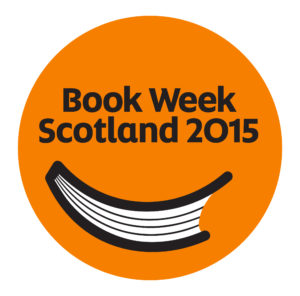 Book Week Scotland, people of all ages and walks of life come together in libraries, schools, community venues and workplaces to share and enjoy books and reading. They are joined in this celebration by Scotland’s authors, poets, playwrights, storytellers and illustrators to bring a packed programme of events and projects to life.
Book Week Scotland, people of all ages and walks of life come together in libraries, schools, community venues and workplaces to share and enjoy books and reading. They are joined in this celebration by Scotland’s authors, poets, playwrights, storytellers and illustrators to bring a packed programme of events and projects to life.
Book Week Scotland is run by the The Scottish Book Trust, and a full programme of events can be found on their website.
To mark the week at Books from Scotland, we’re celebrating the rich tradition of publishing, authorship and reading which has grown up from these shores. We’ve brought this tradition together with the national Year of Food and Drink, to give you HOMEGROWN, a collection of stories a nd recipes from Scottish authors and publishers.
nd recipes from Scottish authors and publishers.
Book Week Scotland 2015 runs from Monday 23 – Sunday 29 November.
Choose a recipe from the list below, cook it up and enjoy with a good book.
- Apple and Bramble Crumble
- Blackthorn Sloe Gin
- Buck Rogers’ Saturday Night Mince & Tatties
- Cashew Nut Roast
- Chopped Liver
- Clootie Dumpling
- Colin’s Roast Mackerel with Red Pesto
- Grace and May’s Macaroni Cheese
- Jam Cake
- Larry’s World Famous Pasta Sauce
- Lentil and Tomato Soup
- Mama Logan’s Roast Potatoes
- Midge Cemetery
- Mutton and Barley Broth
- Nettle Soup
- Parmesan Oven-Fried Chicken
- Rowan Jelly
- Scotch Beef Wellington
- Seafarer’s Stew
- Shepherd’s Pie
- Tablet
Sara Hunt, director of independent publisher Saraband, offers an insight into the creation of Scotland’s only dedicated crime imprint, Contraband.
It was an open-and-shut case, really. A no-brainer. It didn’t need Sherlock Holmes to study the evidence and deduce the best way forward. After all, here we are publishing books in the country that’s home to one of the most thriving crime fiction scenes on the planet: Conan Doyle, Rankin, McDermid, May, Brookmyre, McCall Smith, Rowling/Galbraith, Atkinson… the list of truly great crime writers and fictional detectives from Scotland goes on and on. So why not start our own crime fiction imprint, publishing the new crop of talented Scottish scribblers who have their own criminal tales to tell? Elementary!
That was pretty much the thinking at Saraband Towers a couple of years ago, and Contraband was born, shortly after Saraband won the inaugural Saltire Society Scottish Publisher of the Year Award.
As the only dedicated crime, thriller and mystery imprint in Scottish publishing we already had a USP but, from the get-go, we also wanted to be genuinely different. Your ‘messed-up-cop-on-the-trail-of-a-deranged-killer’ yarn definitely has its place, but we knew there were writers out there bubbling with fresh ideas and creating stories that were imaginative, sometimes offbeat, always original.
 Take Graeme Macrae Burnet’s new book, His Bloody Project, publishing November 2015. Set in 1860s Wester Ross, it’s the story of a brutal triple murder and a whydunnit (rather than a whodunnit). Ingeniously recounted through the accused’s memoir, trial transcripts and newspaper reports, it’s the kind of complex and mesmerising thriller that fans of Peter May’s Lewis Trilogy or Hannah Kent’s Burial Rites will love. Throw in a soupçon of metafictional skulduggery, and you have a crime novel that’s so much more than just a crime novel.
Take Graeme Macrae Burnet’s new book, His Bloody Project, publishing November 2015. Set in 1860s Wester Ross, it’s the story of a brutal triple murder and a whydunnit (rather than a whodunnit). Ingeniously recounted through the accused’s memoir, trial transcripts and newspaper reports, it’s the kind of complex and mesmerising thriller that fans of Peter May’s Lewis Trilogy or Hannah Kent’s Burial Rites will love. Throw in a soupçon of metafictional skulduggery, and you have a crime novel that’s so much more than just a crime novel.
So, our raison d’être from the very start was to publish an eclectic range of crime and thriller writing – ranging from pacy detective stories to intriguing enigmas – and to give a platform to the most exciting new authors, especially those from Scotland.
Happily, and by no means unexpectedly, we soon began receiving some very high quality manuscripts. With an embarrassment of riches we simply began publishing those novels that we loved the most; those with a spark of genius, those with bewilderingly clever plots or, in the case of Neil Broadfoot’s Falling Fast, the book that grabs you by the throat on the first page and never lets go.
Falling Fast has ‘thrills, spills, chills and kills’ and introduces us to Doug McGregor, a story-hungry Edinburgh journalist who uncovers murder and corruption at the top of Scottish politics, along with the ultimate taboo… Falling Fast was immediately shortlisted for the Bloody Scotland Crime Book of the Year Award, 2014.
We could hardly have dared hope for such rapid success for Contraband and we were blown away when, in only our second year, another title was nominated for the 2015 Bloody Scotland Award. The brilliantly titled DM for Murder by Matt Bendoris, with its Twitter killer who guns down a world-famous TV celeb, is a zeitgeist murder mystery, written with savvy, swagger and a good dollop of tongue-in-cheek humour.
Just as these books attracted awards attention, Contraband’s other titles were making the critics sit up and take notice , and even attracted a bit of a cult following. Michael J Malone’s gritty Beyond the Rage introduced us to Kenny O’Neill – ‘Glasgow’s answer to Tony Soprano’. At the other end of Contraband’s broad range was Graeme Macrae Burnet’s debut, The Disappearance of Adèle Bedeau, a psychological thriller that gets deep inside the mind of an awkward outsider whose past comes back to haunt him.
, and even attracted a bit of a cult following. Michael J Malone’s gritty Beyond the Rage introduced us to Kenny O’Neill – ‘Glasgow’s answer to Tony Soprano’. At the other end of Contraband’s broad range was Graeme Macrae Burnet’s debut, The Disappearance of Adèle Bedeau, a psychological thriller that gets deep inside the mind of an awkward outsider whose past comes back to haunt him.
So the story of Contraband so far has very much been about showcasing these emerging Scottish authors. And we’re set to continue in that vein in 2016 with Michael J Malone’s Bad Samaritan, the next in his DI Ray McBain series, and the exciting third instalment in Neil Broadfoot’s Falling Fast series, amongst others.
We’re looking forward to another successful Bloody Scotland Festival in September 2016, following on from this year’s, which saw appearances from most of the Contraband authors.
However, while Scotland remains our priority, we’re also keen to expand the Contraband range and keep offering our readers a diverse selection of titles.
January 2016 will see us publish Fade to Black, the first book by English writer Steve Mullins. An über-cool noir thriller set in London, it’s a British Get Shorty for the media and film world.
It’s too early to mention specifics but we’re also hoping to carry on the spirit of Saraband and publish as many women writers as possible. There’s also a strong possibility that we’ll publish crime titles from overseas, hopefully bringing even more new authors to our readers’ attention. On the other side of that coin, the first translations of Contraband titles are now in preparation for release in 2016, helping our Scottish writers strut their stuff on the international stage.
With so much activity, it’s hard to believe that it’s still relatively early days for Contraband. But we feel we’ve already published some great Scottish crime and thriller writing – and we’re certain there’s more where that came from…
Doug Johnstone has called Edinburgh home for a very long time. But only recently has he tackled it as a landscape in his novels. Here he explores how a city becomes a new thing in the hands of a writer.
For a long time I think I was a little bit scared to write about Edinburgh. My first novel, Tombstoning, had some scenes in the Scottish capital but was mostly set in Arbroath where I grew up. My second book, The Ossians, began and ended in Edinburgh but the rest of it was set all round the Scottish Highlands. And Edinburgh featured again rather obliquely in my third novel, Smokeheads, which was set in Islay but which concerned four main characters who all came from the city.
Looking back on it now, it’s clear to me that I was skirting around the issue, avoiding staring headlong at the city, despite the fact that I’ve now lived there for well over two decades. Initially, I think I felt that Edinburgh was such a well-mapped literary landscape, what could I add to that body of knowledge? Over the centuries, so many great Scottish writers have written about Auld Reekie, it felt rather impudent to think I could improve on any of them.
But I slowly came to realise that it’s not about improving or competing with all the writers who had gone before. Just because Irvine Welsh, Muriel Spark, Walter Scott and Ian Rankin have written about a place, doesn’t mean that I can’t write about it too.
My version of Edinburgh, I came to understand, is just as valid as any of theirs, and it’s very different too. My experience of Edinburgh is different from Muriel Spark’s, different from Ian Rankin’s, different from Kate Atkinson’s and different from Alexander McCall Smith’s. It’s very different from Alexander McCall Smith’s, to be honest.
None of this was really a conscious decision but more of a slowly creeping realisation that I had this wealth of knowledge about the place, I’ve lived the majority of my life there now after all, that it was crazy not to use that.
And so I did. My next three novels – Hit and Run, Gone Again and The Dead Beat – were all set entirely in Edinburgh. Even more than that, they’re all set in specifically constrained areas of the cities, usually away from the tourist traps and ancient stonework of the city centre too.
Generally, I write physically constrained books anyway. It helps add to the sense of claustrophobia, the sense of impending doom, the sense that the characters can’t escape the awful fate that awaits them. And so with my Edinburgh novels, it was exactly the same.
Hit and Run centres around an incident on Queen’s Drive underneath Salisbury Crags, and the characters rarely get farther than a mile away from that focus. Gone Again is set almost entirely on and around Portobello beach, while The Dead Beat focuses on Duddingston and the surrounding area, although it does at least make it as far into town as North Bridge for a bit of last minute drama.
I recently took part in an event at Bloody Scotland, Scotland’s crime writing festival in Stirling, entitled Capital Crime: Edinburgh Noir. Alongside fellow authors James Oswald and Neil Broadfoot, we talked about the city and the place it has in our writing. And what was clear from that event was just what I had been thinking all along – that each writer has a different city, a different Edinburgh, in their mind when they write, and each one is equally valid.
I’ve come to the conclusion that a city can be written and rewritten infinitely. Much is often made of the fact that Edinburgh is a city of contrasts – the rich and the poor living cheek by jowl, the good and the bad rubbing shoulders in the dark pubs of the Old Town. You know, the Jekyll and Hyde nature of the city’s dark past and all that.
And while all that is true, I have a feeling that that juxtaposition exists in any city, indeed, in any place. Writers are usually tuned to that dichotomy, that contrast, and if they’re any use at all at telling a story then they can squeeze some drama out of it in their own individual way. That’s what I try to do, at least.
Edinburgh does have the advantage of an abundance of dramatic scenery – if you’re going to write something dramatic, it helps if you can do it with Arthur’s Seat or Edinburgh Castle looking over your characters.
But for me, I think the most important thing is to really know the place I’m writing about. There are plenty of authors who can write brilliantly about somewhere without ever having been there, and that’s great for them, every single one of us does it differently. But for me, I have to soak up a place before I write about it, I have to know the little secrets, the local knowledge, to hopefully lend the whole thing at least some veracity.
And it’s not as if I’m now just sticking to Edinburgh as a setting for the foreseeable future. My most recent novel, The Jump, is set almost entirely in South Queensferry in the shadow of the Forth Road Bridge, and the book I’m working on at the moment is set completely in Orkney. But will I return to Edinburgh? I think so. I’m certainly not scared to write about Edinburgh anymore.
The creator of beloved forensic scientist Rhona MacLeod and founding member of the Bloody Scotland Crime Festival, Lin Anderson gives us a peek into Scotland’s crime writing fraternity, encourages us to keep secrets as long as possible and indulges our speculations about a meeting between Rhona and Rebus.
BFS: You’ve been coined one of the leading ladies of tartan noir. To your mind, what attributes characterise Tartan Noir? How do you feel your work challenges, upholds or develops that tradition?
 LA: The term Tartan Noir was coined by Ian Rankin when chatting to American crime writer James Ellroy at a crime fiction event in Nottingham. Ian explained he was a crime writer who wrote about Edinburgh and the darker side of Scottish life. He said, ‘You could call it Tartan Noir.’ Ellroy laughed and signed the book ‘To the King of Tartan Noir’. Although even Ian would agree that the real ‘King of Tartan Noir’ is undoubtedly William McIlvanney with Laidlaw. I think it’s distinguishable from other crime writing, because it’s very Scottish in attitude (the old Jekyll and Hyde effect), use of language and humour. Willie said he wanted to write a story that reflected the people he knew, the voices he heard around him in Glasgow. I think that tradition has continued, although it’s not confined to one location in Scotland. As to my forensic series…well it doesn’t feature a male detective with angst and a drink problem, so in that respect it’s different. Dr Rhona MacLeod may not have a drink problem, but she’s a workaholic with a complicated love life.
LA: The term Tartan Noir was coined by Ian Rankin when chatting to American crime writer James Ellroy at a crime fiction event in Nottingham. Ian explained he was a crime writer who wrote about Edinburgh and the darker side of Scottish life. He said, ‘You could call it Tartan Noir.’ Ellroy laughed and signed the book ‘To the King of Tartan Noir’. Although even Ian would agree that the real ‘King of Tartan Noir’ is undoubtedly William McIlvanney with Laidlaw. I think it’s distinguishable from other crime writing, because it’s very Scottish in attitude (the old Jekyll and Hyde effect), use of language and humour. Willie said he wanted to write a story that reflected the people he knew, the voices he heard around him in Glasgow. I think that tradition has continued, although it’s not confined to one location in Scotland. As to my forensic series…well it doesn’t feature a male detective with angst and a drink problem, so in that respect it’s different. Dr Rhona MacLeod may not have a drink problem, but she’s a workaholic with a complicated love life.
BFS: You’ve formally studied forensics, and are very well-respected within the forensics community. What do you enjoy most about that research, and in which ways has it informed your work?
LA: I studied mathematics at university and taught it for a number of years. Maths doesn’t change and the answers are at the back of the book. When I switched to teaching Computing Science I loved the way it was constantly developing and changing. Advances in forensics are there because of the advances made in computing science. At the end of the day though, being a forensic scientist is all about asking the right questions of a scene, just like a good detective. When I come up with an opening scenario, I walk Rhona onto the scene and get her to ask what is forensically interesting about it. Those questions lead the research.
BFS: Can you talk to us a bit about the challenges (if any) of writing women, either as protagonists, victims or perpetrators? Any advantages?
LA: I’m not sure I distinguish by gender particularly, but more by what the character thinks and does. I create characters and try to make them as real as possible (they are to me). One good quote I always remember when writing Rhona is this… ‘A woman is like a teabag. You don’t know her strength until you put her in hot water’. You could happily substitute ‘human’ for ‘woman’ in the quote, although you’re less likely to raise a laugh from the audience with that.
BFS: You once said that, at the end of the day, ‘the crime story is about the people, not the crime.’ What fascinates you most about people, and where do you look for character inspiration?
LA: Everywhere. All drama is a character in action and life is a multitude of small dramas. Listen in to peoples’ mobile conversations on the bus. Watch what people do or say on trains. And read. All stories are an attempt to try and understand the human condition. I once read that writers are observers of life more than participants and I’m inclined to think that may be true.
BFS: You’ve quoted Ian Rankin as saying, ‘Scandinavia doesn’t have better crime writers than Scotland. It just has better PR.’ Why do you think Scotland has produced such a rich vein of crime writing?
LA: The crime writing fraternity in general is very nurturing and encouraging of new writers in the genre. When we set out to create Bloody Scotland we had three aims. The first was to encourage new writing. The second was to showcase established Scottish writers and broaden their reach beyond Scotland. The third was to feature international stars including our own. Bloody Scotland as a brand is there to sell Scottish crime writing worldwide. So in that respect it now is our PR. The talent was there, it just required nurturing and selling.
BFS: Whilst we’re speaking of Ian Rankin, who is a self-professed fan of your main protagonist, what do you suppose Rhona and Rebus would make of each other, if they were to meet?
LA: Mmm. I think Rhona would probably irritate the hell out of Rebus and vice versa, but I think there would definitely be a sizzle there.
BFS: What advice would you give to aspiring crime writers?
LA: Always keep the secret as long as possible. That refers to every secret, small and large, even who’s on the other end of the phone. If you’re about to release some information ask yourself if you can keep it just a little longer. You almost always can.
From BBC Radio presenter, author and chairperson Theresa Talbot comes a bloody tale of the Church that reaches from Ireland to Scotland, from life to death.
Extract from Penance
By Theresa Talbot
Published by Strident Publishing
PROLOGUE
Glasgow, 1958
The body had been wrapped in a piece of torn sheet, then stuffed into the box.
Sally came in from the cold, stopping at the back door to stamp her feet and shake off the wet earth caking her boots. They were miles too big and tied around the ankle with string. Her skinny wee legs were mottled blue with the cold. She caught Irene Connolly watching her from a third floor window, her face and hands pressed hard against the glass. Sally gestured for her to ‘beat it’, hoping to God she’d go back to bed before there was trouble.
Sally’s footsteps sent the rats scurrying for cover as she opened the door. Tiny claws scraped and clicked on the stone floor, tails slithering like big, fat worms.
There were two bundles stored overnight in the pantry. Sally carried them through and laid them on the table beside the third. Each held a similar bundle. Tightly bound. Carefully wrapped. Like tiny Egyptian mummies, so small they could easily fit into one box.
She pushed a strand of hair from her eyes, wiping the sweat from her brow at the same time. Despite the cold, beads of perspiration clustered on her forehead; her thin shirt had become damp and clung to her back from the sheer effort of digging the hardened earth out in the yard. Sally’s small wiry frame concealed a surprising physical stamina. The mental stamina came from knowing no other way of life.
Some said she was simple – ‘There’s a waant wi that yin,’ they’d say. Sally let them think what they liked.
The lid balanced precariously on top of the third bundle, which was still warm. It took all her weight to hold it down. A tiny bone cracked under the pressure, but she carried on regardless. She took a nail from between her teeth and hammered it into the wood. She did this with all six nails before being fully satisfied the lid was secure.
As she wiped the sweat and mucus from her top lip, she stopped dead in her tracks. She pushed her ear against the makeshift coffin and froze.
There was no mistaking the tiny cries from within.
He wasn’t restricted by the form. And so he redefined it. Ian Rankin, Denise Mina, Val McDermid and Christopher Brookmyre are a few among the many who have paid homage to William McIlvanney. Here the man who inspired a generation of crime writers talks to Doug Johnstone.
William McIlvanney in Conversation with Doug Johnstone
Published by Canongate Books
‘Val is a member of the crime writer’s dog fraternity, if you can call a border terrier a dog and not an animated teddy bear. Val once saw a photog raph of my dog, and said, “That is one ugly dog. Even for Glasgow that is an ugly dog.” (She was just stating the obvious as my dog is hideous, a cross between a haggis and a komodo dragon.)
‘My best memory of Val was singing with her and Tania Carver on the sofa at a publishing party in London. We were singing the theme tune to ‘When the Boat Comes In’ and two posh folk walked past. I heard one of them say with a dismissive wave of the hand: “Oh don’t worry about them. They are from the North”.’
From The Killer Cookbook editor, Caro Ramsay
Russian Stuffed Aubergine
By Val McDermid
From The Killer Cookbook
Serves 4
Ingredients
2 medium aubergines
Olive oil
100g pecorino cheese
100g walnuts
100g rocket
80g parmesan shavings
Execution
Slice the aubergines thinly on the diagonal to make a dozen long oval slices. Fry in batches
in hot oil and set aside to cool. Chop cheese and walnuts to breadcrumb consistency and
mix together. (It’s best to do this in an electrical chopper but you can do it by hand.) Place
a generous teaspoon of the cheese and nut mix on an aubergine slice and roll it up. Serve
garnished with rocket and Parmesan shavings and a light dressing of olive oil.
The Killer Cookbook was published to raise funds for Professor Sue Black’s Million for a Morgue campaign at the University of Dundee. Though the morgue is now up and running, all funds from the ongoing sale of the book will go to buy more state of the art forensic equipment: http://www.millionforamorgue.com/content/killer-cookbook
What is Tartan Noir? Which authors belong to this global crime fiction phenomenon? Which books should you read first, next, again, or not at all? And what are the many historical, political, and cultural influences that have woven themselves into the Tartan Noir success story? Your journey through the genre starts here …
Extract from Tartan Noir: the essential guide to Scottish crime fiction
By Len Wanner
Published by Freight Books
Typically, detective fiction tells the story of one man’s quest for truth, if not justice. Stereotypically, the fictional detective tells his own story, that of a lone wolf who lays down the law of the jungle as he roams the mean streets of an urban waste land in search of redemption for our sins, a good man who all too often does the wrong thing, but always for the right reason. Through the lens of this ‘private eye’ the author of such a novel lets us look at what goes on when the lights go out. He, for he too is typically a man, lets an outsider do what the police can or will not do when he looks into private indecencies of public interest. Not only does this furnish him with a narrative strategy, it also lets us see the public’s indifference to the private indignities which often attend the exposure of perceived indecencies, and that soon forms our shared resolve to find a way through the thicket of clues and conspiracies. Of course, time and again the alpha male investigator loses said way among loose women and looser plots. He will even lose consciousness, repeatedly, and at times he will risk losing the powers of both consecutive thought and plot continuity. And yet he loses neither his courage nor our confidence. On the contrary, he gradually wins our trust as a professional with principles, the last of the good guys, and in the end this knight errant finds his grail, often tarnished yet always transformative.
So much for the stereotypical detective novel. Yet beyond this stereotype, detective fiction has long been notable for a number of serious literary merits, including the wide held belief that the first form of crime fiction was a detective story. Seeing as that would make detective fiction the starting point of a diverse literary heritage that has spanned some 180 years, a good starting point for this chapter may be 1833 and “Théorie de la Démarche”, “The Theory of the Walk”. According to its author, Honoré de Balzac, this essay paved the way for a new investigative technique by expanding ground-level sociological observation with wide-angled metaphysical insight. The first to use this technique in detective fiction was Edgar Allan Poe. In a short story of 1840, titled “The Man of the Crowd”, he presented the case of a curious Londoner who develops theories about criminal degeneracy as he looks at people through a crowd of strangers, and this story has since been seen as the X-ray of detective fiction.
Based on the infamous, grisly murders in the underbelly of Edinburgh, this novel was originally published in the Dundee People’s Journal in 1864 and 1865 by one of the most successful serial novelists of his day, David Pae. The new edition provides a window into the popular Victorian imagination and breathes new life into this classic tale.
Extract from Mary Paterson, or, The Fatal Error
By David Pae, edited by Caroline McCracken-Flesher
Published by ASLS
Two years have come and gone, and once more it is an autumn day – a day of blue sky and bright sunshine – a day when throughout the whole extent of broad and bonny Scotland the reapers are in the fields cutting down the yellow grain, enlivening their toil by laughter and song. In all the vales and in all the uplands of the mellow landscape are many bands to be seen, with their bright hook-blades flashing in the sun as they bury them among the shocks of corn, while on the still and sultry air the sound of their happy voices are wafted among the woods and over the slopes of purple heather, and down the smiling course of the crystal stream, where the latest wild flowers of the year are blooming in richest loveliness, and where woodland warblers are swelling the thanksgiving song which universal nature is raising to the beneficent creator who has crowned the year with his goodness.
But this same autumn day can show another and darker scene than this. In the dingy, dirty closes of old Edinburgh there is to be seen little of the blue sky and less of the bright sunshine, and there the faintest echo of the reaper’s song is not heard, and the happy harvest joy is unknown.
In a little dingy room of a house in one of the narrowest and dirtiest closes in the West Port, a group of four living persons are assembled. Two of these were Burke and Helen M‘Dougal. Burke sat in a corner near the window on a cobbler’s stool, mending a shoe, and Helen, and another woman were huddled together on stools, near the embers of a fire which had cooked the breakfast they had just eaten.
Burke had much more of a broken-down appearance than when last we saw him as a day-labourer in Stirlingshire. He and Helen had come to Edinburgh as they proposed, but idle inclinations and drunken habits had prevented them from prospering much in the world. With the last remnant of Helen’s money Burke became a travelling merchant, in which occupation he succeeded but poorly. Then he wrought at various country places, and finally he took to shoe-mending, and he and Helen became lodgers in this house in Tanner’s Close, West Port.
The woman with whom Helen huddled on the hearth was the landlady of the house, a dirty, slattern, sensual, hard-featured woman, with an Irish cast of countenance; her hair seemed red, so far as the colour could be determined through the dirt; her face had a bold, masculine expression; and her whole appearance denoted less of the woman than of the virago.
Her protector, the lord and master of the establishment, sat on a higher stool at the other side of the fire, moodily smoking a black short pipe. A more repulsive-looking wretch than he was, mortal eye could scarcely look upon. His small head sloped away back from the brow to the crown, very much like an idiot’s. The face below the brow, however, was not idiotic in its expression, but it was worse. To use a good Scotch term, it was ‘‘gruesome’’ to look at. There was a huge mouth, high cheek bones, and small oval grey eyes, a most extraordinary distance from each other. They seemed little other than horizontal slits in the skin of the face, into which a little grey glancing ball had been inserted. But the horrid, loathsome leer which was their natural and almost invariable expression, made one uncomfortable, even by looking at them, and suggested ideas of a disposition of the cruelest character. This man was Hare.
Richard Marggraf Turley moves us beyond the Scottish borders, to London, 1810. With endorsements from the Financial Times, the Guardian and the Irish Times amongst others, this novel explores a labyrinthine city of asylums, brothels and secret spaces, in which poets rub shoulders with pimps, and where the only constant is illicit desire.
Extract from The Cunning House
By Richard Marggraf Turley
Published by Sandstone Press
The rat crept along the wall of the burying ground in Portugal Street, where stinks and other odours of the dead were given off, before doubling back the length of Clare Market. Past the disreputable tavern with its ramshackle bays.
The July air was even more unsustaining than usual, and he was no longer at his best … He gazed down at the silky patches showing through his coat. Still nimble enough, though. Filling his shallow lungs, he darted across the street for no other reason than to prove he still could, aware he’d needlessly drawn the eyes of a huddle of men cutting for guineas on the pavement, then slipped into the alleys and dark passages fanning out between Vere Street and Stanhope Street, the shortest way down to the river.
Someone not far away was making a poor imitation of a blackbird’s call.
On the Strand, Rat-man judged it safe to rear on two feet. He stepped into a shadowy doorwell to catch his wind. Above him, Venus and Mars were bright specks; he imagined the chill between planets, that unbearable space. But a body in motion was a body not yet cold – and there was work to do. The latest intelligence from France spoke of a munition so potent, wherever a man stood when it ignited was the centre; of grenades packed with chemicals that rendered soldiers irresistible to each other.
It had always been the Frenchies. He remembered handing General Wolfe his gloves at Quebec after a day of clinging to rocks. Long ago now. France, a nation of barley and buckwheat eaters, moustachioed fawns and stinky women.
He set off again, ducking at the corner of Somerset House into an ill-lit passage strewn with ashes and oyster shells. Above him, chandeliers flamed in a high gallery. Then he was on the river bank, pattering over loose pyramids of burnt clay tiles.
The unfinished bridge towered ahead, its cunning interfrictions of iron and granite reaching out from either side of the river towards a deafeningly dark hole. Rat-man’s sharp eyes found the tiny entrance to the service tunnel. He flipped open his watch. He was early.
This year, Craig Russell took home Bloody Scotland’s accolade for Crime Novel of the Year, with his thrilling novel The Ghosts of Altona, the latest in his Jan Fabel series. The author of two other series and winner of a CWA Dagger Award, Russell is one of the leading voices in Scottish crime fiction. But, first and foremost, he’s just a bloody good writer. Here he talks to BFS about genre, the personality of a city and how crucial it is to exercise the writing muscle.
BFS: You’re a prolific novelist, with two established series of crime novels and a third, non-crime one taking shape. Can you tell us a little bit about what drew you to the crime genre in the first instance?
CR: I always rather pompously describe myself as ‘a writer who happens to write about crime, rather than a crime writer’. I wanted to be a writer for as long as I can remember and, for me, the most important thing was to write, what genre I wrote in was a secondary consideration. In fact, I personally believe writing good crime fiction, or fiction of any genre, is all about making characters live and breathe in a believable way, creating a powerful sense of place, time and context, establishing a texture, mood and tone—not sitting down consciously to write ‘crime fiction’. I think John Le Carré is a good example of that: first and foremost he rights about the human condition, about relationships and frailties and betrayals—and that’s what makes him the greatest writer ever of spy fiction.
And not everything I write is crime: The Third Testament, for example, which I wrote under the pseudonym of Christopher Galt, is as far from crime as you’re likely to get. But, obviously, the bulk of my work to date has been crime fiction; the odd thing is that many of the themes, concepts and forms I pursue in my non-crime fiction are there in my crime fiction too. And that’s exactly why I find crime fiction so appealing: it is so flexible and accommodating that you can explore all kinds of styles, all kinds of ideas. Because of the structure of the crime novel—taking the reader on a journey of discovery and ultimate revelation—there are no limits to the environment you can build and the palette you paint with.
BFS: A great deal of your work draws on other narrative traditions – including folklore and fairy tales– as well as historical references. How do you approach your research, and in which ways does it inform your fiction?
CR: That’s a very good point—a lot of what I write discusses the nature and purpose of storytelling itself; how we’re conditioned by the folklore and mythologies around us—and not just ancient mythologies, but also the influence of the media on our lives.
In the Fabel series, mythology, history and storytelling often provide the background to the stories. In fact, my protagonist Jan Fabel’s surname is a wordplay on that theme: Fabel is German not just for fable, but also both for ‘a tall story’ and for a ‘story plot’. In Brother Grimm, for example, a serial killer is inspired by the ancient, quintessential European fairy tales gathered by the Grimm brothers—all of which were much, much darker than the cleaned up versions we tell our children today! In The Ghosts of Altona, the latest Fabel novel, murders are taking place among a group of people united by their fascination for Gothic literature: Mary Shelley and Edgar Allan Poe loom large in the story as well as the legend of the Golem, which inspired Shelley to write ‘Frankenstein’.
As you’ve pointed out, given the nature of the novels I write, there is lot of research involved. And the research certainly does inform the fiction because it is continuous—I research and write simultaneously and the two elements combine to shape the novel. I never can understand writers who hire researchers: for me it’s a huge part of the development process, ideas sparking from what you learn as you research. And it’s huge fun!
BFS: Your narrative voices are very distinct, and each series has a very distinct voice from the other. How did you develop the texture of these voices, and what do you enjoy about returning to them?
CR: Being a writer, for me at least, is a little like having multiple personality disorder. When I write, I become immersed in the world—the period, the location, the kind of social or political environment, and the characters themselves. Being a Scot intensifies the sense of at least a dual personality (it’s no coincidence that The Strange Case of Jekyll and Hyde was written by a Scot). Like most Scots, I have a strong sense of being a European; but, like the Irish and the Scots-Irish, we are aware of our connection with the New World, with the US and Canada. What I’ve done is divide these aspects: when I write a Fabel novel, I become a Northern German; when I write a Lennox novel, I become a Canadian. The interesting thing is that both Fabel and Lennox are something of outsiders in their chosen contexts of Hamburg and Glasgow.
BFS: Your cityscapes seem almost inextricable from your narrative voices, with the Fabel novels set in Hamburg and the Lennox novels in Glasgow. What did you find compelling about these two cities?
CR: Big, big, BIG personalities. There are cities (I won’t name them!) that you visit and leave with no real sense of the ‘vibe’ or the personality behind them, that leave you with a meh feeling. Then there are the Pragues, Barcelonas, Bostons, Hamburgs, New Yorks, Copenhagens and Glasgows—the cities that have huge personalities that often are right in your face. I’ve always said that the cities in my books aren’t locations, they’re main characters.
One thing that I hadn’t thought of that someone pointed out to me is that I tend to set my novels in cities that are major seaports. I think that’s an important element: the sense of transition, people passing through, a sense of a window on a wider world.
BFS: The Lennox novels are set in 1950s Glasgow, a place described in one of your book blurbs as ‘not somewhere you’d choose to be unless you were born to it’. How did you choose the setting, and were there specific challenges or limitations you faced when constructing crime investigations of a certain period?
CR: Ah, yes… that phrase isn’t my doing. Publisher blurb. The reason I chose Glasgow is because, with Lennox, I wanted to write a classic noir inspired piece. There are certain qualities and elements classic noir demands: a tough, uncompromising urban landscape, lots of shadows and menace and, most of all, a dark, often bleak and always cynical humour. Glaswegians deliver that in bucketloads. The new Queen Elizabeth University Hospital superhospital hadn’t even opened when Glaswegians renamed it the Death Star. I rest my case.
The 1950s is probably the most ‘noir’ decade, so it fitted to set the novels in that period. But more than that, it was a period of colossal upheaval for Britain—and for Glasgow more than anywhere. The British Empire was no longer crumbling, it was in a state of total collapse; that meant for Glasgow—the ‘Second City of the Empire’ that had built most of the ships and heavy engineering for an empire that had spanned the globe—that its entire reason for being was being challenged. The legacy of this is still felt today in Glasgow.
Also, classic noir is a North American form. Glasgow has got to be the most ‘American’ city in Europe. A lot of the architecture in the city went up at the same time and had the same architectural influences Eastern seaboard cities in the US: Glasgow tenements and New York brownstones share the same architectural DNA. The language and turn of phrase is also similar. Glasgow just emerged as the most natural setting.
 BFS: A big congratulations for winning Bloody Scotland’s 2015 Crime Novel of the Year. What’s next for you? Any upcoming projects you can let us in on?
BFS: A big congratulations for winning Bloody Scotland’s 2015 Crime Novel of the Year. What’s next for you? Any upcoming projects you can let us in on?
CR: The next Lennox novel, The Quiet Death of Thomas Quaid, is nearing completion and will be out next year. The latest Fabel movie in German won the ratings war and had the biggest audience for Saturday prime time, beating the German version of the X-Factor into second place—so there’ll be more Fabel movies in the pipeline. Biblical which was released as The Third Testament in the UK has been optioned for the screen by a Hollywood production company and Lennox has had its option with the BBC renewed—so lots might be happening there.
Once I finish this Lennox novel, I have a standalone and a Fabel to write. So I’m going to be busy!
BFS: Do you have any advice for aspiring crime writers?
CR: Don’t think of yourselves as crime writers—think of yourselves as writers. And look outwards—use your writing as a means of understanding others, seeing the world through other eyes. It’s an essential part of developing credible characters. Read as much as you can, as widely as you can, but read outside the genre and try to find your own, distinctive voice. Whatever you do, don’t try to write like someone else.
And most of all write. It doesn’t matter if you bin it—write every day. It’s how you work-out your writer’s muscles.
This year, Craig Russell took home Bloody Scotland’s accolade for Crime Novel of the Year, with his thrilling novel The Ghosts of Altona, the latest in his Jan Fabel series. The author of two other series and winner of a CWA Dagger Award, Russell is one of the leading voices in Scottish crime fiction. But, first and foremost, he’s just a bloody good writer. Here he talks to BFS about genre, the personality of a city and how crucial it is to exercise the writing muscle.
BFS: You’re a prolific novelist, with two established series of crime novels and a third, non-crime one taking shape. Can you tell us a little bit about what drew you to the crime genre in the first instance?
CR: I always rather pompously describe myself as ‘a writer who happens to write about crime, rather than a crime writer’. I wanted to be a writer for as long as I can remember and, for me, the most important thing was to write, what genre I wrote in was a secondary consideration. In fact, I personally believe writing good crime fiction, or fiction of any genre, is all about making characters live and breathe in a believable way, creating a powerful sense of place, time and context, establishing a texture, mood and tone—not sitting down consciously to write ‘crime fiction’. I think John Le Carré is a good example of that: first and foremost he rights about the human condition, about relationships and frailties and betrayals—and that’s what makes him the greatest writer ever of spy fiction.
And not everything I write is crime: The Third Testament, for example, which I wrote under the pseudonym of Christopher Galt, is as far from crime as you’re likely to get. But, obviously, the bulk of my work to date has been crime fiction; the odd thing is that many of the themes, concepts and forms I pursue in my non-crime fiction are there in my crime fiction too. And that’s exactly why I find crime fiction so appealing: it is so flexible and accommodating that you can explore all kinds of styles, all kinds of ideas. Because of the structure of the crime novel—taking the reader on a journey of discovery and ultimate revelation—there are no limits to the environment you can build and the palette you paint with.
BFS: A great deal of your work draws on other narrative traditions – including folklore and fairy tales– as well as historical references. How do you approach your research, and in which ways does it inform your fiction?
CR: That’s a very good point—a lot of what I write discusses the nature and purpose of storytelling itself; how we’re conditioned by the folklore and mythologies around us—and not just ancient mythologies, but also the influence of the media on our lives.
In the Fabel series, mythology, history and storytelling often provide the background to the stories. In fact, my protagonist Jan Fabel’s surname is a wordplay on that theme: Fabel is German not just for fable, but also both for ‘a tall story’ and for a ‘story plot’. In Brother Grimm, for example, a serial killer is inspired by the ancient, quintessential European fairy tales gathered by the Grimm brothers—all of which were much, much darker than the cleaned up versions we tell our children today! In The Ghosts of Altona, the latest Fabel novel, murders are taking place among a group of people united by their fascination for Gothic literature: Mary Shelley and Edgar Allan Poe loom large in the story as well as the legend of the Golem, which inspired Shelley to write ‘Frankenstein’.
As you’ve pointed out, given the nature of the novels I write, there is lot of research involved. And the research certainly does inform the fiction because it is continuous—I research and write simultaneously and the two elements combine to shape the novel. I never can understand writers who hire researchers: for me it’s a huge part of the development process, ideas sparking from what you learn as you research. And it’s huge fun!
BFS: Your narrative voices are very distinct, and each series has a very distinct voice from the other. How did you develop the texture of these voices, and what do you enjoy about returning to them?
CR: Being a writer, for me at least, is a little like having multiple personality disorder. When I write, I become immersed in the world—the period, the location, the kind of social or political environment, and the characters themselves. Being a Scot intensifies the sense of at least a dual personality (it’s no coincidence that The Strange Case of Jekyll and Hyde was written by a Scot). Like most Scots, I have a strong sense of being a European; but, like the Irish and the Scots-Irish, we are aware of our connection with the New World, with the US and Canada. What I’ve done is divide these aspects: when I write a Fabel novel, I become a Northern German; when I write a Lennox novel, I become a Canadian. The interesting thing is that both Fabel and Lennox are something of outsiders in their chosen contexts of Hamburg and Glasgow.
BFS: Your cityscapes seem almost inextricable from your narrative voices, with the Fabel novels set in Hamburg and the Lennox novels in Glasgow. What did you find compelling about these two cities?
CR: Big, big, BIG personalities. There are cities (I won’t name them!) that you visit and leave with no real sense of the ‘vibe’ or the personality behind them, that leave you with a meh feeling. Then there are the Pragues, Barcelonas, Bostons, Hamburgs, New Yorks, Copenhagens and Glasgows—the cities that have huge personalities that often are right in your face. I’ve always said that the cities in my books aren’t locations, they’re main characters.
One thing that I hadn’t thought of that someone pointed out to me is that I tend to set my novels in cities that are major seaports. I think that’s an important element: the sense of transition, people passing through, a sense of a window on a wider world.
BFS: The Lennox novels are set in 1950s Glasgow, a place described in one of your book blurbs as ‘not somewhere you’d choose to be unless you were born to it’. How did you choose the setting, and were there specific challenges or limitations you faced when constructing crime investigations of a certain period?
CR: Ah, yes… that phrase isn’t my doing. Publisher blurb. The reason I chose Glasgow is because, with Lennox, I wanted to write a classic noir inspired piece. There are certain qualities and elements classic noir demands: a tough, uncompromising urban landscape, lots of shadows and menace and, most of all, a dark, often bleak and always cynical humour. Glaswegians deliver that in bucketloads. The new Queen Elizabeth University Hospital superhospital hadn’t even opened when Glaswegians renamed it the Death Star. I rest my case.
The 1950s is probably the most ‘noir’ decade, so it fitted to set the novels in that period. But more than that, it was a period of colossal upheaval for Britain—and for Glasgow more than anywhere. The British Empire was no longer crumbling, it was in a state of total collapse; that meant for Glasgow—the ‘Second City of the Empire’ that had built most of the ships and heavy engineering for an empire that had spanned the globe—that its entire reason for being was being challenged. The legacy of this is still felt today in Glasgow.
Also, classic noir is a North American form. Glasgow has got to be the most ‘American’ city in Europe. A lot of the architecture in the city went up at the same time and had the same architectural influences Eastern seaboard cities in the US: Glasgow tenements and New York brownstones share the same architectural DNA. The language and turn of phrase is also similar. Glasgow just emerged as the most natural setting.
 BFS: A big congratulations for winning Bloody Scotland’s 2015 Crime Novel of the Year. What’s next for you? Any upcoming projects you can let us in on?
BFS: A big congratulations for winning Bloody Scotland’s 2015 Crime Novel of the Year. What’s next for you? Any upcoming projects you can let us in on?
CR: The next Lennox novel, The Quiet Death of Thomas Quaid, is nearing completion and will be out next year. The latest Fabel movie in German won the ratings war and had the biggest audience for Saturday prime time, beating the German version of the X-Factor into second place—so there’ll be more Fabel movies in the pipeline. Biblical which was released as The Third Testament in the UK has been optioned for the screen by a Hollywood production company and Lennox has had its option with the BBC renewed—so lots might be happening there.
Once I finish this Lennox novel, I have a standalone and a Fabel to write. So I’m going to be busy!
BFS: Do you have any advice for aspiring crime writers?
CR: Don’t think of yourselves as crime writers—think of yourselves as writers. And look outwards—use your writing as a means of understanding others, seeing the world through other eyes. It’s an essential part of developing credible characters. Read as much as you can, as widely as you can, but read outside the genre and try to find your own, distinctive voice. Whatever you do, don’t try to write like someone else.
And most of all write. It doesn’t matter if you bin it—write every day. It’s how you work-out your writer’s muscles.

